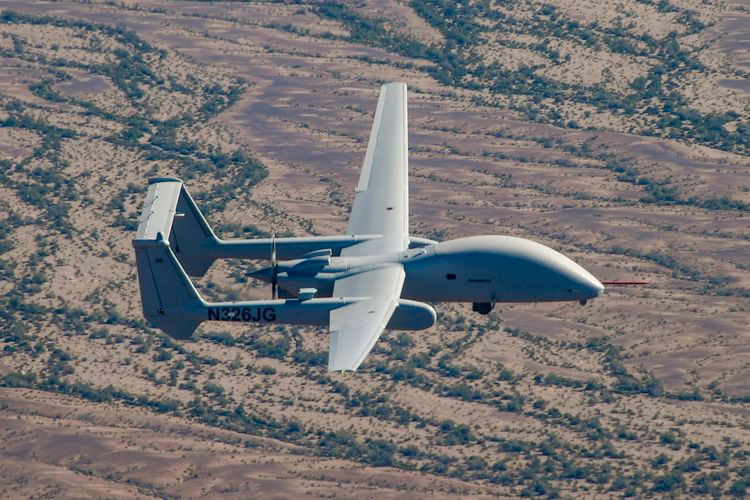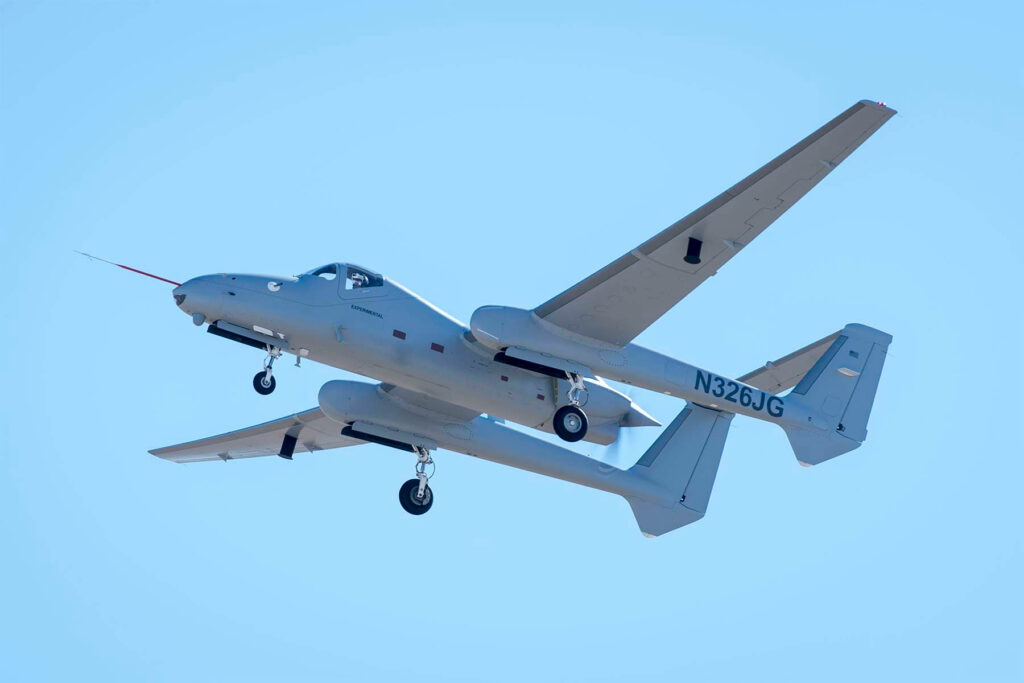The Northrop Grumman Firebird is an optionally piloted intelligence-gathering aircraft with a 65 ft wingspan, 1,240 lb payload capacity, and 40-hour endurance.
The Northrop Grumman Firebird is a medium-altitude, long-endurance intelligence-gathering aircraft developed by Northrop Grumman’s subsidiary, Scaled Composites. Designed as an optionally piloted vehicle (OPV), it can operate both manned and unmanned. The aircraft features a twin-boom pusher configuration, a 65-foot wingspan, and a payload capacity of 1,240 pounds. Powered by a Lycoming TEO-540 flat-six piston engine, it achieves a top speed of 230 mph and can operate at altitudes up to 30,000 feet. The Firebird is capable of carrying up to four modular reconnaissance payloads simultaneously, allowing for rapid reconfiguration to meet diverse mission requirements. Its design emphasizes flexibility, endurance, and real-time data collection across multiple intelligence domains.
History of the Development of the Northrop Grumman (Scaled Composites) Firebird
In the late 2000s, the increasing demand for versatile ISR platforms led Northrop Grumman to explore innovative solutions that could bridge the gap between manned and unmanned operations. The objective was to develop an aircraft capable of providing real-time intelligence while offering the flexibility to operate with or without a pilot, depending on mission requirements.
On February 9, 2009, Rick Crooks, a Northrop Grumman executive, proposed the concept of an optionally piloted vehicle (OPV) to Scaled Composites. This collaboration aimed to leverage Scaled Composites’ expertise in innovative aircraft design to create a platform that could meet the evolving needs of ISR missions.
The development phase progressed rapidly, and the Firebird conducted its maiden flight in February 2010. This initial flight marked the beginning of a series of tests to validate the aircraft’s performance and versatility. In October 2010, the Firebird demonstrated its capability to collect information from multiple sources simultaneously during a demonstration flight in Sacramento, California, showcasing its potential to defense officials.
The Firebird was publicly unveiled on May 9, 2011, highlighting its unique design and operational capabilities. Between May 23 and June 3, 2011, it participated in the Empire Challenge exercise, where it displayed its ability to carry multiple payloads and rapidly switch them out, underscoring its adaptability to various mission scenarios.
Designed under the guidance of Burt Rutan, the Firebird was among the last aircraft he oversaw before his retirement in April 2011. The aircraft’s development was driven by the need for a flexible ISR platform that could be quickly reconfigured to meet diverse mission requirements, reducing the time and cost associated with deploying different aircraft for varying tasks.
In March 2018, a new variant of the Firebird with an increased wingspan conducted its first flight, aiming for a launch in early 2019. However, in April 2022, Northrop Grumman announced the suspension of Firebird production due to a lack of export customers, though the company indicated that the aircraft would remain available for interested parties.
Throughout its development, the Firebird has been recognized for its innovative approach to ISR operations, offering a platform that combines the strengths of manned and unmanned systems while providing the flexibility to adapt to rapidly changing mission demands.

Design of the Northrop Grumman (Scaled Composites) Firebird
The Firebird’s design reflects a focus on versatility and adaptability, catering to a wide range of ISR missions. Its twin-boom pusher configuration is a notable feature, with the engine mounted at the rear, driving a pusher propeller. This layout enhances aerodynamic efficiency and provides an unobstructed field of view for forward-mounted sensors.
Dimensions:
- Wingspan: 65 feet (19.8 meters)
- Length: 34 feet (10.4 meters)
- Height: 9.7 feet (2.95 meters)
The aircraft’s high-aspect-ratio wing, with a slight forward sweep, contributes to its long-endurance capabilities by reducing drag and improving lift-to-drag ratio.
Payload Capacity:
The Firebird can carry up to 1,240 pounds (562 kilograms) of payload, accommodating multiple sensor modules simultaneously. This modularity allows operators to equip the aircraft with a combination of high-definition video cameras, infrared sensors, radar systems, and signals intelligence equipment, depending on mission requirements.
Propulsion:
Powered by a Lycoming TEO-540 flat-six piston engine, the Firebird employs a three-bladed pusher propeller. This engine choice balances performance with fuel efficiency, supporting the aircraft’s extended endurance.
Operational Flexibility:
One of the Firebird’s defining features is its optionally piloted capability, allowing it to operate with or without a human pilot onboard. This flexibility enables it to be tailored to the specific mission, whether requiring remote operation for hazardous environments or manned operation for rapid deployment or compliance with civilian airspace regulations.
Avionics and Modularity:
The Firebird’s modular design allows operators to integrate and swap out sensors within hours, minimizing downtime and maximizing mission readiness. Its avionics suite supports real-time data streaming to ground stations, enabling efficient intelligence dissemination and decision-making.
Advantages:
- Versatility: The ability to carry multiple payloads simultaneously reduces the need for deploying multiple platforms.
- Operational Flexibility: Optionally piloted capability enhances deployment options and reduces the need for dedicated UAV infrastructure.
- Endurance: Long flight durations ensure sustained ISR coverage over target areas.
Drawbacks:
- Limited Payload Capacity: Compared to larger UAVs, the Firebird’s payload capacity is lower, restricting it to ISR roles.
- Dependence on Line-of-Sight or Satellite Communications: As with many UAVs, extended operations depend on robust communication links, which can be vulnerable to interference.
The Firebird’s design emphasizes adaptability and efficiency, making it a unique asset for modern ISR operations.
Performance of the Northrop Grumman (Scaled Composites) Firebird
The performance capabilities of the Firebird demonstrate its suitability for medium-altitude, long-endurance (MALE) operations, particularly in intelligence gathering and surveillance roles.
Engine and Power:
The Lycoming TEO-540 flat-six piston engine generates approximately 350 horsepower (260 kW). Its air-cooled design enhances reliability, particularly in varied operational climates. This engine’s integration with the pusher propeller configuration optimizes fuel efficiency and reduces noise, a key feature for ISR missions requiring discretion.
Speed and Altitude:
- Maximum Speed: 230 mph (370 km/h)
- Cruise Speed: 150-180 mph (240-290 km/h)
- Operational Ceiling: 30,000 feet (9,144 meters)
The Firebird’s operational ceiling allows it to stay clear of most ground-based threats, while its cruise speed ensures efficient area coverage during ISR missions.
Range and Endurance:
The Firebird boasts an impressive endurance of 30-40 hours, depending on payload configuration. With a fuel capacity designed for long missions, it can cover extensive areas without the need for refueling, making it ideal for persistent surveillance and monitoring.
Payload and Sensor Integration:
The Firebird supports up to 1,240 pounds (562 kilograms) of payload distributed across multiple hardpoints. This capacity accommodates a range of ISR equipment, such as:
- EO/IR Cameras: For high-definition imaging and thermal sensing.
- Synthetic Aperture Radar (SAR): For all-weather reconnaissance and mapping.
- Signals Intelligence (SIGINT) Equipment: For monitoring and analyzing electronic emissions.
Comparison to Competitors:
When compared to other MALE platforms like the General Atomics MQ-9 Reaper or Textron Aerosonde HQ, the Firebird’s optionally piloted capability sets it apart. While the MQ-9 offers a higher payload capacity and endurance, the Firebird’s modularity and hybrid operation provide unmatched mission flexibility for operators requiring dual-mode operation.
Operational Efficiency:
The Firebird’s endurance and cost-effective operation make it particularly suited for border patrol, disaster response, and extended ISR missions. Its ability to rapidly reconfigure payloads ensures it remains mission-relevant even as operational requirements evolve.
Variants of the Northrop Grumman (Scaled Composites) Firebird
The Firebird program includes two primary configurations, each tailored for specific operational needs:
1. Original Firebird (2011):
The initial variant was designed to demonstrate the feasibility of optionally piloted operations and modular payload integration. It served as a technology demonstrator for multi-mission ISR capabilities.
2. Firebird Production Model (2018):
The updated production model features a longer wingspan, improved endurance, and enhanced avionics. This version is optimized for operational use, with refinements to its payload capacity and communication systems.

Military Use and Combat of the Northrop Grumman (Scaled Composites) Firebird
The Firebird has not yet seen direct combat deployment, but its capabilities position it as a valuable asset for ISR and multi-mission roles.
Intelligence and Surveillance Roles:
The Firebird excels in ISR missions, particularly for border security, counter-terrorism, and disaster response. Its ability to carry multiple sensor payloads simultaneously ensures comprehensive coverage of operational areas, whether for real-time intelligence or post-mission analysis.
Military Applications:
While primarily used for surveillance, the Firebird’s modularity allows for integration into electronic warfare and signals intelligence missions. Its ability to transmit real-time data to ground stations supports military decision-making during complex operations.
Operational Integration:
The Firebird’s optionally piloted capability allows it to operate in civilian airspace, making it suitable for joint operations where manned and unmanned assets must coexist. This feature is particularly useful for intelligence-sharing missions between military and civilian agencies.
Competing Systems:
Platforms like the MQ-9 Reaper and Textron Scorpion offer similar ISR capabilities but lack the hybrid operational flexibility of the Firebird. While the Reaper excels in endurance and payload, the Firebird’s rapid payload reconfiguration and dual-mode operation make it ideal for dynamic mission profiles.
Export Potential:
Although Northrop Grumman suspended production in 2022 due to limited export interest, the Firebird remains available for specialized operators. Its appeal lies in its flexibility, particularly for nations seeking dual-use platforms for military and civilian ISR applications.
The Northrop Grumman Firebird bridges the gap between manned and unmanned ISR platforms, offering a unique blend of flexibility, modularity, and endurance. Its ability to operate in both piloted and unmanned modes makes it a versatile choice for diverse mission requirements. While it faces competition from established MALE platforms, the Firebird’s design and operational flexibility ensure it remains a valuable asset for specialized ISR applications.
Back to the Drones, UAVs, UCAVs page